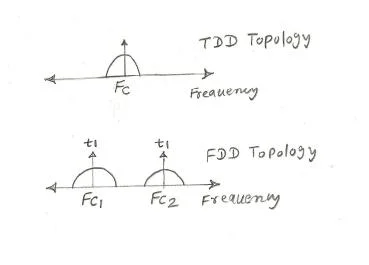Featured post
- Get link
- X
- Other Apps
FDD Vs TDD | Difference Between FDD And TDD In Wireless Communication
FDD Vs TDD | Difference Between FDD And TDD In Wireless Communication
FDD (Frequency Division Duplex) and TDD (Time Division Duplex) are basic terminologies used in frame structures of mobile wireless communications and other telecom networks. FDD is a technique which allows use of two separate frequency bands in uplink and downlink where as TDD is a technique which allows use of same frequency band in both uplink and downlink at different time instants or slots. These topologies are widely used in wireless communication systems such as WLAN, Fixed and Mobile WiMax, 4G LTE, 5G NR and so on. Let us compare FDD vs TDD and derive difference between FDD and TDD topologies used in mobile wireless communication.
What Is FDD ?
In FDD topology, available frequency spectrum is divided into two separate bands, one for transmitting data and the other for receiving data. These two bands are separated by guard band to prevent interference. As shown in the figure, two different frequency bands Fc1 and Fc2 are used by transmit and receive paths at same time instant.

Let us understand concept of FDD with example of communication between base station (BS) and subscriber station (SS) in cellular wireless system. In FDD, both uplink and downlink transmissions are assigned two separate frequencies Fc1 and Fc2 respectively. Both utilizes same time slot('t1') to transmit. Here uplink refers to transmissions from SSs to BS where as downlink refers to transmission from BS to SSs.
In FDD, the transmit and receive operations occur simultaneously but on different frequencies. Hence it provides a constant and continuous data transmission experience. FDD system requires more power compare to TDD system due to requirements of separate hardware RF modules for transmit and receive chains for different frequency operations.
What Is TDD ?
In TDD system, same frequency band FC is used by both transmit and receive paths at different time instants. The communication channel switches rapidly between transmitting and receiving modes and devices take turns transmitting and receiving during specific time intervals.
TDD dynamically divides available time into alternating time slots for both uplink and downlink transmission. The advantage of TDD is that it is more flexible in allocating resources based on varying traffic demands. The disadvantage is that it requires careful synchronization to avoid interference between devices.
As shown in the figure, both uplink and downlink transmissions are arranged one after the other on time scale i.e. uplink is transmitted at say 't1' instance and downlink is transmitted at 't2' instance. Here t2 equals t1 plus some time duration. Both uplink and downlink transmissions will take place at same RF carrier frequency(Fc).
TDD systems are cheap compare to FDD systems due to requirement of less RF modules such as Synthesizer, Local Oscillators, filters etc. MAC layer in TDD system is complex compare to FDD system, as it has to deal with accurate time synchronization between the transmit and receive systems.
TDD is favourable compare to FDD for advanced antenna techniques such as beamforming and AAS(Adaptive Antenna System) due to channel reciprocity in TDD between the uplink and downlink paths.
Following table mentions difference between TDD and FDD topologies.
| Parameters | FDD | TDD |
|---|---|---|
| Full Form | Frequency Division Duplexing | Time Division Duplexing |
| Spectrum Allocation | Uses separate frequency bands for uplink (UL) and downlink (DL). | Uses same frequency band for both uplink and downlink but allocates different time slots for them. |
| Guard band | Requires to prevent interference between UL and DL | Not required as time slots separate transmission and reception |
| Simultaneous operation | Possible as it can transmit and receive on separate frequencies. | Not possible, it alternates between transmit and receive using unique time slots |
| Synchronization | FDD requires less complex synchronization between devices since they operate on separate frequencies. | TDD requires precise synchronization between devices to ensure accurate switching between transmit and receive slots |
| Hardware complexity | FDD requires specific hardware for both uplink and downlink | TDD oftem use same hardware for both transmit and receive which simplifies design |
| Channel asymmetry | FDD is more suitable for asymmetric traffic in DL and UL | TDD can handle channel asymmetry more effectively due to its dynamic time slot allocation |
| Frequency planning | FDD requires careful frequency planning | TDD requires less strict frequency planning |
| System latency | FDD may have slightly lower latency due to simultaneous transmit and receive operations | Latency in TDD can be influenced by time slot duration |
| Interference management | Less prone to self interference due to separate frequencies | Requires careful coordination to avoid interference between devices sharing same band |
Conclusion : Both FDD and TDD have their advantages and are suitable for different scenarios. LTE system utilizes both in its frame structures to achieve benefits of both topologies. Refer LTE FDD And TDD which compares FDD vs TDD frame structures used in 4G LTE system.
- Get link
- X
- Other Apps
Popular Posts
5G NR MAC Layer-Architecture, Channel Mapping, Procedures
- Get link
- X
- Other Apps
5G NR TBS Calculation | 5G NR Transport Block Size Calculation
- Get link
- X
- Other Apps

Comments
Post a Comment